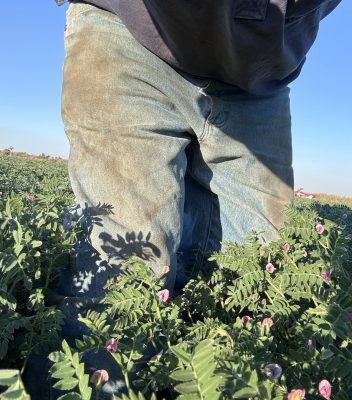ABARES has piled 200,000 tonnes on to its national chickpea estimate thanks to a stellar growing season in Queensland and New South Wales.

Chickpea crops like this one on the western Downs of southern Queensland are standing tall at full flower and looking at well above-average yield potential. Photo: Jake Hamilton
It is expected to see Australia produce 1.3 million tonnes (Mt) of chickpeas, up 18 percent from its initial June estimate of 1.1Mt, up 171 percent from the 2023-24 crop, and 70pc higher than the 10-year average to 2023-24.
“This reflects a significant expansion in area and high expected yields in NSW and Qld, given high expected margins and favourable conditions,” ABARES said in its quarterly Australian Crop Report released today.
“If realised, this will be the second-highest chickpea harvest on record.”
ABARES forecast for lentil production is up 6pc, or 100,000t, from the initial forecast to 1.7Mt.
“This is more than double the 10-year average to 2023-24, with the expansion in area planted to lentils expected to more than offset lower yields.”
In Qld, the chickpea area estimate at 380,000ha is unchanged from the initial June estimate, and is up 73pc year on year, while production at 640,000t is up from the initial forecast of 560,000t.
In NSW, both area and production estimates are up from the initial forecasts, with area now seen at 350,000ha, up 40,000ha from the June figure, and production at 650,000t, up 110,000t.
South Australia is Australia’s biggest lentil producer, and the initial 2024-25 estimates of 810,000t from 460,000ha have been revised up to 860,000t from 470,000ha.
Upward revisions have also been made for Victoria, where its lentil crop is forecast at 790,000t from 430,000ha, up from 765,000t from 400,000ha seen in the June figures.
As with wheat, barley, and canola crops, lentils in SA and Vic have had a challenging start.
“Planting and establishment conditions were unfavourably dry across major cropping regions in South Australia and parts of Victoria.
“Dry conditions throughout the season have led to moisture stress with winter crop yields in these regions forecast to be below average.”
The ABARES report said below-average winter rainfall in key cropping areas is expected to limit Vic production.
“Due to the recent drawdown of subsoil moisture, sufficient and timely rainfall will be important in the coming weeks to maintain above average yields for some regions.
“Potential downside risks for the Mallee and Wimmera region persist if they continue to remain dry, which could further constrain yields.”
The situation in SA is similar.
“Below-average rainfall through winter has seen soil-moisture levels continue to decline across most cropping regions, delayed crop establishment and reduced yield prospects.
“While overall yields are forecast to fall, there is some regional variability, with localised rainfall events in the lower and eastern Eyre Peninsula in June cushioning yield reductions in these areas.”
Source: ABARES

HAVE YOUR SAY